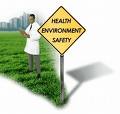Better to Be Safe than Sorry
Why do we wear seatbelts? Why do we bring a surplus of diapers and multiple changes of clothes when we take our babies on a single outing? Why do we wear helmets while biking and skiing? Why – because by golly, we’re smart kids and we have learned to intrinsically employ the precautionary principle…now if only our law and policy makers could do the same.
According to Safer Chemicals, Healthy Families, “there are 82,000 chemicals available for use in the U.S. yet only about 200 chemicals have been assessed for safety. Only 5 chemicals have been removed from use based on health and safety concerns.” Currently, in the United Sates, law makers require strong, and in many cases, conclusive evidence that a contaminant has adverse human health effects before preventative actions are taken. In other words, the burden is on people to prove a chemical is unsafe before lawmakers will take action. The problem with this policy, however, is “serous, evident effects such as endocrine disruption, climate change, [and] cancer…can seldom be linked to a single cause. Scientific standards of certainty may be impossible to attain when causes and outcomes are multiple; latent periods are long; timing of exposure is crucial; unexposed, “control” populations do not exist; or cofounding factors are unidentified (www.sehn.org ).
So, if definitively linking specific contaminants to specific adverse health outcomes is sometimes a nearly impossible task, how could our government better protect us? The U.S. should borrow a page from the European Union’s playbook and begin to adopt the Precautionary Principle – that’s how. The 1998 Wingspread Conference characterizes the Precautionary Principle as “when an activity raises threats of harm to the environment or human health, precautionary measures should be taken even if some cause and effect relationships are not fully established scientifically.” If a contaminant is strongly suspected of causing harm, precautionary measures should be taken. The Bay Area Working Group on the Precautionary Principle explains if a Precautionary Principle were to be adopted, “those who are introducing toxins into our environment [will] have greater accountability and responsibility for choosing the safest course of action to avoid harm.” Under the Precautionary Principle, the government would require that chemicals be tested for safety before they are allowed to be used in the products we put on our bodies and use to clean our houses, workplaces and schools.
If you would like to the let your legislators know that you would rather be safe than sorry, visit Safer Chemicals, Healthy Families and send the letter to Congress urging lawmakers to utilize a Precautionary Principle approach to chemical reform. Go ahead and drop us a comment - we’d love to learn what you think of the Precautionary Principle. And please do let us know if you are inspired to send a letter to Congress – perhaps your enthusiasm will be contagious!
p.s. I sent my letter.
Keep Reading...
Tags: chemical policy reform, environmental health, environmental toxins, family health, green healthcare, PBDE chemicals, personal care products, Precautionary Principle

